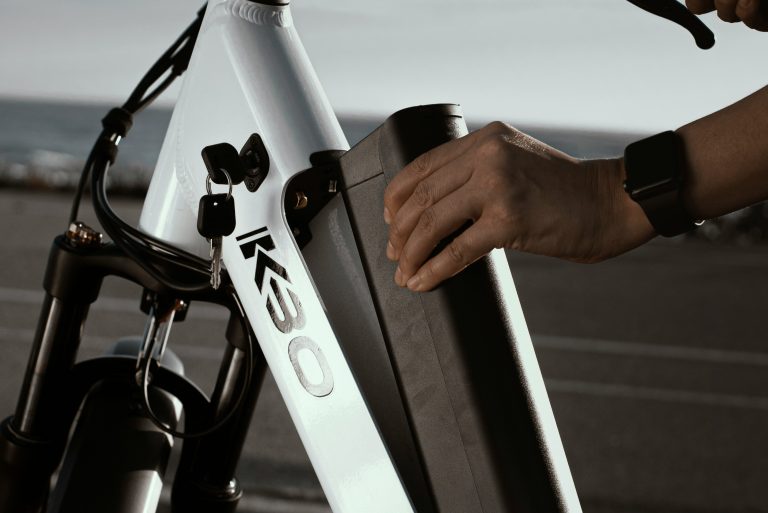When Should I Replace My Electric Bike Battery?
Are you wondering when it’s time to replace your electric bike battery? If so, we’ve got you covered! In this article, we’ll discuss the telltale signs that indicate your battery may need replacing, giving you all the information you need to keep your bike running smoothly. Whether you’re a casual rider or a seasoned cyclist, knowing when to replace your electric bike battery is essential for optimal performance. So, keep reading to learn more about this important aspect of maintaining your electric bike.

Factors affecting the lifespan of an electric bike battery
Battery chemistry
The chemistry of the battery plays a crucial role in determining its overall lifespan. Lithium-ion batteries are commonly used in electric bikes due to their high energy density and long cycle life. They have a longer lifespan compared to lead-acid and nickel-metal hydride batteries. Therefore, it is important to choose a battery with the right chemistry for optimal longevity.
Battery capacity
The capacity of an electric bike battery refers to its ability to store energy. A higher capacity battery generally lasts longer between charges compared to a lower capacity battery. When purchasing an electric bike, it is essential to consider your range requirements and choose a battery with a sufficient capacity to meet your needs.
Frequency of usage
The frequency at which you use your electric bike can impact the lifespan of the battery. If you frequently use your bike for long rides or commute long distances, the battery will go through more charge and discharge cycles, potentially shortening its lifespan. On the other hand, if you use your electric bike less frequently, the battery may last longer.
Charging habits
How you charge your electric bike battery can also affect its lifespan. It is recommended to avoid frequent shallow charging and instead charge the battery fully after each use. Partial charging can degrade the battery capacity over time. Additionally, it is important to use the charger provided by the manufacturer and avoid using incompatible chargers as they may not have the correct voltage or current specifications.
Environmental factors
Environmental conditions can impact the lifespan of an electric bike battery. High temperatures can accelerate the degradation of the battery, while extreme cold temperatures can reduce its overall performance. It is important to avoid exposing the battery to extreme temperatures and store it in a cool, dry place when not in use.
Signs indicating the need for battery replacement
Decreased mileage per charge
If you notice that your electric bike’s range per charge has significantly decreased, it may be a sign that your battery is nearing the end of its lifespan. As the battery degrades over time, its capacity to hold a charge diminishes, resulting in reduced mileage.
Reduced power output
A battery nearing the end of its lifespan may exhibit reduced power output. You may notice a decrease in the bike’s overall performance, such as slower acceleration or difficulty climbing steep hills. This can be a clear indication that it is time to replace the battery.
Frequent battery error messages
If your electric bike’s display frequently shows battery error messages, it may be a sign of a failing battery. These error messages could indicate issues such as low voltage or battery temperature abnormalities, which can arise from an aging battery.
Difficulty in holding charge
An aging battery may struggle to hold a charge for an extended period, even when not in use. You may find that the battery drains quickly or loses charge overnight. If you consistently experience difficulty in maintaining a stable charge, it is likely time to consider replacing the battery.
Physical damage to the battery
Visible physical damage, such as cracks or leaks in the battery casing, should not be ignored. Physical damage can compromise the battery’s performance and safety. If you notice any signs of damage, it is important to replace the battery as soon as possible.
Typical lifespan of electric bike batteries
Lithium-ion batteries
Lithium-ion batteries are the most commonly used type of battery in electric bikes. On average, lithium-ion batteries can last between 2-5 years, depending on several factors such as usage, charging habits, and battery chemistry. With proper care and maintenance, some lithium-ion batteries can last even longer.
Lead-acid batteries
Lead-acid batteries, while less common in electric bikes nowadays, tend to have a shorter lifespan compared to lithium-ion batteries. On average, lead-acid batteries last between 1-3 years. They require regular maintenance, such as checking fluid levels and ensuring proper charging, to maximize their lifespan.
Nickel-metal hydride batteries
Nickel-metal hydride (NiMH) batteries are an older technology and are less commonly used in electric bikes today. They typically have a shorter lifespan compared to lithium-ion batteries, lasting between 2-4 years. However, advancements in battery technology have made lithium-ion batteries the preferred choice for electric bike batteries due to their higher energy density and longer lifespan.
Battery replacement considerations
Original battery vs. third-party replacement
When it comes to replacing your electric bike battery, you have the option of choosing an original battery from the manufacturer or a third-party replacement. Original batteries may offer better compatibility and performance, but they are often more expensive. Third-party replacements can be a more affordable option, but it is important to ensure they are compatible with your specific bike model.
Compatibility with the bike model
When selecting a replacement battery, it is crucial to consider its compatibility with your electric bike model. Different bike models may have different battery sizes, shapes, and connectors. It is recommended to consult your bike’s manual or contact the manufacturer to ensure you choose a battery that is compatible with your bike.
Cost of replacement
The cost of battery replacement can vary depending on the brand, chemistry, and capacity of the battery. Original batteries from the manufacturer tend to be more expensive compared to third-party replacements. It is important to consider your budget and weigh the cost against the battery’s expected lifespan and performance.
Warranty and return policies
Before purchasing a replacement battery, it is advisable to check the warranty and return policies. A reputable manufacturer or seller should offer a warranty period, which can provide peace of mind against manufacturing defects or premature battery failure. Understanding the warranty terms and return policies can ensure a smoother replacement process if any issues arise.

Steps to assess battery performance
Tracking mileage per charge
One way to assess your electric bike battery’s performance is to track the mileage per charge. By keeping a record of the distance you can travel on a single charge, you can monitor any gradual decrease in battery capacity over time.
Monitoring power output
Regularly monitoring the power output of your electric bike can help determine if the battery is still performing optimally. If you notice a significant decrease in power or sluggish performance, it may indicate that the battery needs replacement.
Checking error messages
Pay attention to any error messages displayed on your electric bike’s control panel. If you frequently encounter battery-related error messages, it can be an indication that the battery is deteriorating and needs to be replaced.
Testing charge holding capacity
To test the battery’s ability to hold a charge, fully charge it and then leave it disconnected for a few days. Reconnect the battery and check if it retains its charge. If the battery quickly drains after a short period of disconnection, it may be a sign that it needs to be replaced.
Inspecting physical condition
Regularly inspecting the physical condition of the battery is essential for assessing its performance. Look for any visible signs of damage, such as cracks or leaks. Additionally, check the battery terminals and connectors for corrosion or loose connections.
Maintaining and extending battery lifespan
Proper charging practices
Follow proper charging practices to maintain and extend the lifespan of your electric bike battery. Fully charge the battery after each use, avoid frequent shallow charging, and use the charger provided by the manufacturer. Adhering to these practices can help prevent premature degradation and ensure optimal battery performance.
Avoiding extreme temperatures
Extreme temperatures can have a negative impact on battery performance and lifespan. Avoid exposing the battery to extreme heat or cold. Store the battery in a cool, dry place when not in use. If you ride in extreme weather conditions, consider insulating the battery or using a battery cover to protect it from temperature fluctuations.
Storing the battery correctly
When storing the electric bike for an extended period, it is important to store the battery correctly. Fully charge the battery before storage and disconnect it from the bike. Store the battery in a cool, dry place, away from direct sunlight and extreme temperatures. It is also advisable to periodically check and recharge the battery to prevent it from entering a deep discharge state.
Regular maintenance and cleaning
Performing regular maintenance on your electric bike battery can help prolong its lifespan. Clean the battery terminals and connectors with a damp cloth to prevent corrosion. Ensure that the battery remains securely attached to the bike and does not loosen over time. Following the manufacturer’s maintenance guidelines can help keep the battery in optimal condition.

Battery replacement process
Researching replacement options
Before starting the battery replacement process, it is important to research and explore different replacement options. Compare prices, reviews, and specifications of various batteries to choose the most suitable replacement for your electric bike.
Removing the old battery
To replace the battery, start by disconnecting it from the bike. Depending on the bike model, this may involve removing screws, detaching connectors, or releasing latches. Follow the instructions provided in the bike’s manual or seek professional assistance if needed to ensure safe removal.
Installing the new battery
Once the old battery is removed, carefully install the new battery following the manufacturer’s instructions. Ensure that the connectors are securely attached and the battery is properly seated in its designated position. Double-check that all connections are tight and secure.
Testing functionality
After installing the new battery, ensure its functionality before using the electric bike. Confirm that the battery is charging properly, and all the bike’s features, such as the display and power-assist modes, are functioning correctly. Take a test ride to ensure the bike operates smoothly and that the new battery meets your performance expectations.
Recycling and disposing of old batteries
Local recycling programs
It is important to responsibly recycle or dispose of old electric bike batteries. Many cities have local recycling programs that accept and recycle batteries. Check with your local recycling center, waste management facility, or city government for information on how to properly recycle your old battery.
Battery disposal regulations
Certain regions have specific regulations for battery disposal due to their environmental impact. Research and comply with any disposal regulations applicable to your area. Improper disposal can pollute the environment and pose hazards to human health.
Battery collection centers
Some battery manufacturers or retailers have collection centers where you can drop off your old batteries. These centers ensure that the batteries are properly recycled or disposed of in accordance with environmental regulations. Check with the battery manufacturer or your local retailer for information on battery collection centers.

Tips for purchasing a new electric bike battery
Choosing the right battery chemistry
Consider the advantages and disadvantages of different battery chemistries when choosing a replacement battery. Lithium-ion batteries are the most popular choice due to their long lifespan and high energy density. However, it is important to evaluate your specific needs and choose the chemistry that best aligns with your usage requirements.
Determining the appropriate capacity
Select a battery with the appropriate capacity to meet your riding needs. Consider factors such as your average riding distance, terrain, and frequency of use. Choosing a battery with sufficient capacity ensures that you do not experience range anxiety and can ride comfortably without needing frequent recharges.
Checking compatibility with the bike
Ensure that the replacement battery is compatible with your electric bike model. Check the battery’s specifications and compare them with your bike’s requirements. Pay attention to factors such as battery size, shape, voltage, and connector compatibility.
Considering brand reputability
Research reputable brands when purchasing a new electric bike battery. Established brands typically have a track record of producing reliable and high-quality batteries. Reading customer reviews and seeking recommendations can also provide valuable insights into the performance and reliability of different brands.
Reading customer reviews
Before making a final decision, read customer reviews of the battery you are considering. Pay attention to feedback regarding longevity, performance, and reliability. Real-life experiences from other electric bike owners can help you make an informed choice and select a battery that meets your expectations.
Conclusion
The lifespan of an electric bike battery can be influenced by various factors, including battery chemistry, capacity, frequency of usage, charging habits, and environmental conditions. Understanding the signs that indicate the need for battery replacement can help ensure optimal performance and safety. When replacing a battery, consider factors such as original vs. third-party replacements, compatibility, cost, and warranty. Assessing battery performance through tracking mileage, monitoring power output, and checking for error messages can assist in determining the need for replacement. Proper maintenance, following charging practices, and avoiding extreme temperatures can help extend battery lifespan. The battery replacement process involves researching, removing the old battery, installing the new battery, and testing functionality. Recycling and disposing of old batteries should be done responsibly through local recycling programs or designated collection centers. Tips for purchasing a new electric bike battery include choosing the right chemistry, determining the appropriate capacity, checking compatibility, considering brand reputability, and reading customer reviews. By considering these factors and following the outlined guidelines, you can ensure a longer lifespan and optimal performance for your electric bike battery.








